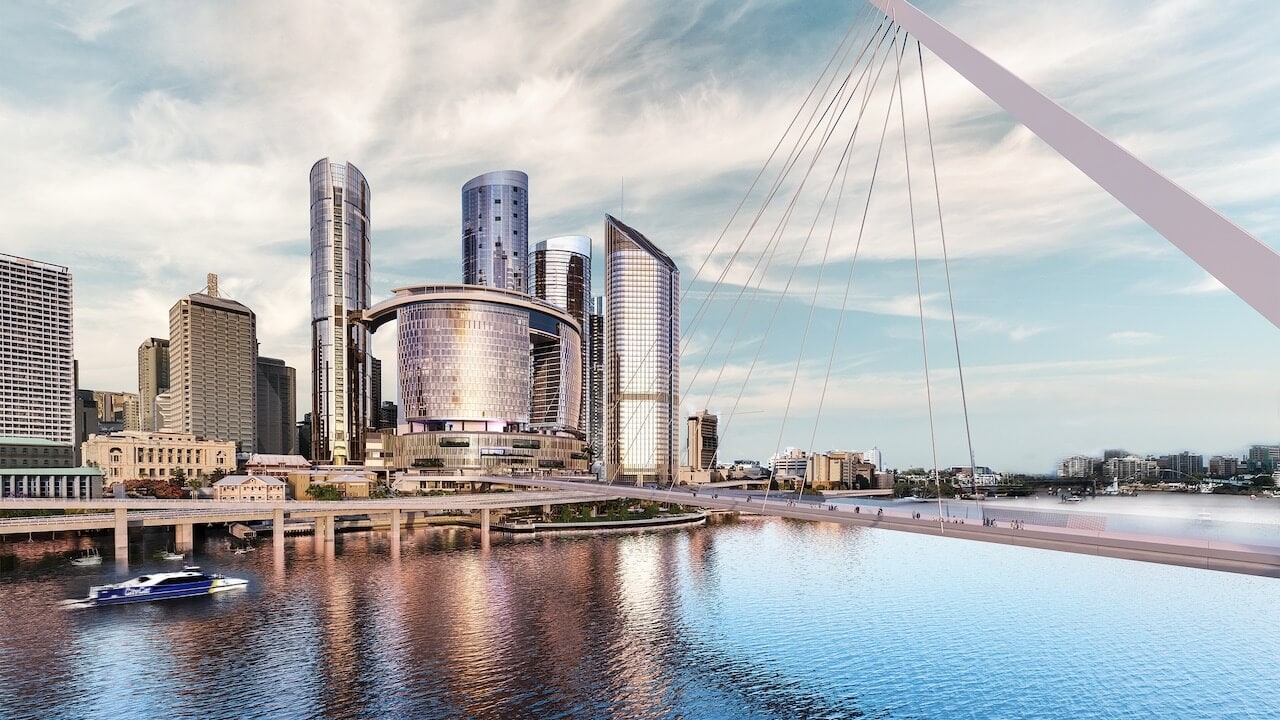First published on Built Environment Economist, Australia & New Zealand.
Standfirst: The team behind the $3.6 billion Queen’s Wharf Brisbane development has harnessed the power of Building Information Modeling (BIM) to deliver a highly complex project with myriad stages, packages, and stakeholders. The integration of BIM ensured effective quantity take-off and cost estimation, accurate quantities, and improved visualization for accurate measurements.
Expected to open in 2022, Queen’s Wharf Brisbane is a world-class integrated resort development that will transform the Central Business District (CBD) and river’s edge. The Destination Brisbane Consortium is delivering the $3.6 billion development, which will cover more than 12 hectares—equivalent to 10% of Brisbane’s CBD.
The development encompasses 50 new bars, cafes and restaurants; 2,000 apartments across three residential towers; and more than 1,000 premium hotel rooms operating under four hotel brands, one with a casino. The existing Treasury Casino will close in 2022.
There is plenty of public space in the development as well: the equivalent of 12 football fields. This public space will help to accommodate the additional 1.39 million visitors expected in Brisbane as a result of the project. Impressively, the development is also sustainable, having earned a 6-star Green Star Communities rating.
Project Delivery: The Power of BIM
PDC, now known as DBM Vircon, was engaged by the Destination Brisbane Consortium in 2017 to deliver a Building Information Modeling (BIM) facilities management solution for the development.
DBM Vircon worked alongside the Consortium’s design consultants and contractors, based in the client’s office. In delivering the project, 16 different pieces of software were utilized by 39 contributing organizations. DBM Vircon had over 340 models under management, with 215 individual models processed weekly.
According to Alastair Brook (Director, Digital Engineering, DBM Vircon),“Queen’s Wharf Brisbane is a flagship project for our company, pulling together a key team of highly skilled digital engineers to deliver a complex project with multiple interfaces, stages, programs, software and contributing parties. It was a true open BIM project. This allowed us to develop an integrated model to use in operations planning, four years before project delivery.”
DBM Vircon collaborated with Rider Levett Bucknall (RLB)—who was responsible for delivering all quantity surveying services to the Consortium—throughout the project.
According to Matt Long (Director, RLB), BIM technology was first employed to verify the project scope. “Navisworks and Revit were utilized to verify model object properties and attributes, which included location and zoning, design coding, materiality, specifications, lengths and areas. The BIM model also contained publisher information within each object’s property, allowing for smoother consultant feedback.”
The Queen’s Wharf Brisbane BIM management plan featured several procurement packages, each of which was input into each object’s parameters. “By switching the layers in the BIM model on and off, we were able to quickly and easily verify visually, on-screen, that each package was correctly modeled,” said Long.
Quantity extraction was also streamlined. “Having early involvement in the BIM process allowed RLB to utilize DBM Vircon’s management plan to integrate useful model attributes into consultant models, including lengths, areas, volumes, reinforcement ratios, and steel tonnages. Utilizing a combination of DBM Vircon’s models, and our in-house ROSS5D software, we were able to extract accurate quantities from the models and apply these to our cost plans.”
“Employing this process, bulk checks of manual take-off were achieved through quantity extraction and layering investigations. This enabled efficient confirmation of measurements.”
“Given the size of the Queen’s Wharf Brisbane development, BIM allowed the cost planning of complex structures, facades and fitouts, to be understood rapidly while enabling accurate take-off of quantitates.
With BIM models delivering visualizations that incorporate a component-based representation of building systems with lifelike textures, RLB’s team was able to view the development from every possible angle and get a feel for the overall size and layout.
“A combination of Navisworks, Revit and Autodesk 360 enabled the BIM models to be viewed both in the office and on-site. Visualizing the model greatly enhanced our understanding of the complex Queen’s Wharf Brisbane design,” said Long.
Data Rich Models Deliver A Raft of Benefits
With digital construction technologies like BIM becoming more and more popular, building and construction industry practice is undergoing rapid change. New technologies are already boosting construction industry productivity, as well as integration and collaboration between technical disciplines. As such, data rich BIM models can deliver a raft of benefits for quantity surveyors.
According to Brook, “The use of BIM offers a range of benefits for quantity surveyors, including efficient and effective quantity take-off and cost estimation, reliable and accurate quantities, and improved visualization of individual elements for more accurate measurements.”
BIM enables quantity surveyors to assess and affect the design and delivery process for better commercial outcomes. However, for the most effective utilization of BIM, it is essential that quantity surveyors are involved from the outset of a project, and regularly communicate with the design team—just as RLB was involved from the outset of the Queen’s Wharf Brisbane development.
“RLB was involved from the outset of the design process. This helped ensure that the BIM guidelines and associated cost planning measurement parameters were included within the consultant models, and confirmed throughout design development,” said Long.
“Collaborating on the Queen’s Wharf Brisbane development with an integrated BIM manager worked well for the project team from a knowledge sharing and collaboration point of view. The development also has a 99-year lease and, as such, every design consideration has whole of life costs taken into account. This was a refreshing approach to the planning, design and construction experience.”
DBM Vircon Wins Prestigious 2019 buildingSMART International Award
DBM Vircon was awarded the prestigious 2019 buildingSMART International Award in the Design category for their work on Queen’s Wharf Brisbane.
Presented in Beijing in late 2019, the award recognizes exemplary use and implementation of BIM. Over 100 projects were submitted for initial review, with the other finalists in the Design category including the China Railway Design Corporation for the Jingxiong High Speed Railway, and DEUBIM GmbH for FMZ Leinefelde.
According to Vinod Muthanna (CEO, DBM Vircon), “We are honoured to be recognized for the work on Queen’s Wharf Brisbane. The awards program truly showcased the depth and breadth of technical excellence and innovation being applied to the challenges of interoperability during collaborative project delivery and asset operations.”
“For over three years, our team has been based on-site at the Destination Brisbane Consortiums offices, collaborating with the other consortium members, to contribute to the success of the project. This Award recognises our consulting team’s leadership in the Digital Engineering space.”
“We’d like to thank all those who contributed to this achievement, especially our valued client Destination Brisbane Consortium, software partners, consultants and contractors,” said Muthanna.



